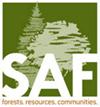Spatial Spillover Effects of Pine Sawtimber Stumpage Prices in the US South
IF 1.5
4区 农林科学
Q2 FORESTRY
引用次数: 2
Abstract
Timberland returns have three main drivers: biological growth, timber price, and land value. Among three of these drivers, timber price is the most volatile. Therefore, modeling and predicting timber prices has been of great concern for timberland investors and other stakeholders. In this study, the spatial dependency and spillover effect of sawtimber prices were investigated across 11 southern states with three different spatial panel models. The findings revealed a strong positive spatial dependency in sawtimber prices across these states, and the observed spillover effect for significant independent variables was over 35% of the total effect. Similarly, pulpwood prices not only have positive impact on the sawtimber prices of a given state but also on its contiguous states. In addition, the impact of COVID-19 pandemic on sawtimber prices was positive and significant. These results would facilitate the valuation of timberland investments as well as predict future timber prices. Study Implications: The sawtimber prices of one state positively affect the future sawtimber prices of neighboring states in addition to its own. Similarly, a shock in a given state also affects the sawtimber prices of its neighbors. Given the volatile nature of timber prices, gaining a better understanding of spatial integration of timber markets improves prediction of sawtimber price fluctuations and trends that ultimately help timberland investors to make effective decisions.美国南部松材立木价格的空间溢出效应
林地收益有三个主要驱动因素:生物生长、木材价格和土地价值。在这三个驱动因素中,木材价格波动最大。因此,木材价格的建模和预测一直是林地投资者和其他利益相关者非常关注的问题。本文采用三种不同的空间面板模型,对南方11个州锯材价格的空间依赖和溢出效应进行了研究。研究结果显示,这些州的锯材价格存在强烈的正空间依赖性,并且观察到的重要自变量的溢出效应超过总效应的35%。同样,纸浆木材价格不仅对一个州的锯材价格有积极影响,而且对其邻近的州也有积极影响。此外,2019冠状病毒病大流行对锯材价格的影响是积极而显著的。这些结果将有助于评估林地投资以及预测未来的木材价格。研究启示:一个国家的锯材价格除了对本国的锯材价格外,还会对邻近国家的未来锯材价格产生积极的影响。同样,某一特定州的冲击也会影响其邻国的锯材价格。鉴于木材价格的不稳定性,更好地了解木材市场的空间一体化可以改善对锯材价格波动和趋势的预测,最终有助于林地投资者作出有效的决策。
本文章由计算机程序翻译,如有差异,请以英文原文为准。
求助全文
约1分钟内获得全文
求助全文
来源期刊

Forest Science
农林科学-林学
CiteScore
2.80
自引率
7.10%
发文量
45
审稿时长
3 months
期刊介绍:
Forest Science is a peer-reviewed journal publishing fundamental and applied research that explores all aspects of natural and social sciences as they apply to the function and management of the forested ecosystems of the world. Topics include silviculture, forest management, biometrics, economics, entomology & pathology, fire & fuels management, forest ecology, genetics & tree improvement, geospatial technologies, harvesting & utilization, landscape ecology, operations research, forest policy, physiology, recreation, social sciences, soils & hydrology, and wildlife management.
Forest Science is published bimonthly in February, April, June, August, October, and December.
 求助内容:
求助内容: 应助结果提醒方式:
应助结果提醒方式:


